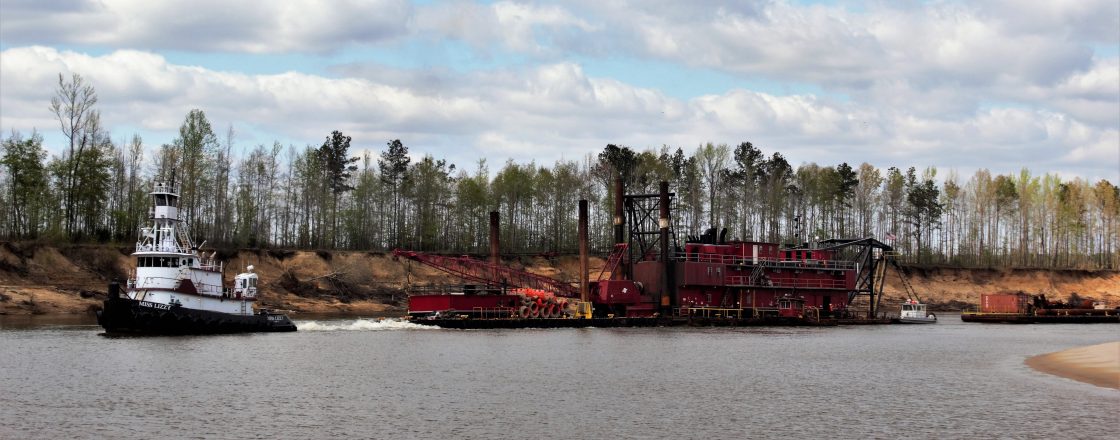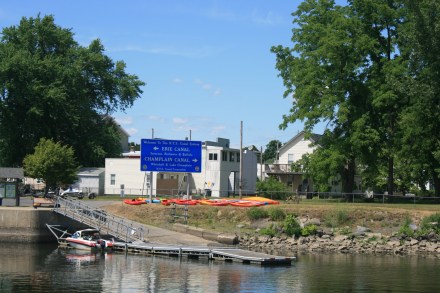Iconic may be an over-used word, but a canal about which an iconic song has been written, perhaps assumes iconic status too.
The Erie Canal was first proposed in 1807, and construction began in 1817. At a time when entrepreneurs in England could see how the canal system helped to bring prosperity to the industrial areas of England, the benefits of an East-West waterway linking Buffalo on Lake Erie, with Albany on the Hudson River and thus New York, were obvious. The Mohawk Valley separating the Adirondack Mountains to the north and the Catskills to the south was chosen for the route. Since the original canal opened in 1825, for use by barges driven by horses and mules, there have been many enlargements and improvements. As a result of the canal construction, Buffalo grew from a population of 200 settlers in 1820, to more than 18,000 in 1840, New York City became the Atlantic home port for the Midwest, and New York became known as the Empire State.
So it was with some excitement that we left Coeyman’s Landing, 10 miles south of Albany on the Hudson River, to start our journey through the Erie Canal and on to the Great Lakes and Canada.
A few pictures of Albany. I particularly liked the U-haul building.
Troy is a few miles upriver from Albany. The Troy Federal Lock, at the junction between the tidal Hudson River and the Mohawk River, was a big one.
We felt slightly apprehensive about the locks. We were au fait with English locks on English canals, and we had travelled up the Thames from Limehouse Basin to Oxford, but American locks were an unknown quantity. The guide to the New York State Canal System afforded some insight – pictograms showed the crew attached to long ropes which dangled deep down into the bowels of the lock. How hard would it be to hang on to the rope, if the lock filled quickly causing turbulence and strong currents, or there were strongish winds? Then there was the question of etiquette. The guide stated clearly that it was not part of the lock-keeper’s job description to assist boaters. Presumably they would just look on sardonically in the face of boaters’ ineptitude.
It proved not too difficult to grab the dangling rope with the boat hook, but we learned the hard way that the fenders need to be much higher when you’re going into the locks than when you’re docking. And the lock-keepers were unfailingly efficient and friendly.
At Waterford, where the Erie Canal starts, following the Mohawk River, sometimes alongside it and sometimes a part of it, there’s a flight of locks in quick succession as the canal rises steeply above the Hudson Valley. The flight is said to be the largest in America. (For the UK Canal cognoscenti: they were nothing compared to Tardebigge or Foxton Flights.) But they were on a much grander scale, and the dark blue and gold livery lent an attractive cohesion to the New York State Canal System perhaps lacking in the UK Canals and River Trust.
Above lock 8, we were weather-bound by very strong winds. Large parts of the canal are actually broad river, and we didn’t feel confident about negotiating the locks in Force 5 winds.
We got the bikes out instead and set off along the riverside cycle track, with the object of having coffee in Schenectady, 3 miles away. We were thwarted by some large trees that had come down in the winds, and completely blocked our path, so we had to turn round. But we did have a nice view of the Mohawk River.
We saw the ruins of the old Lock 23, once an important unloading point for Schenectady, and abandoned when the canal was enlarged in 1903.
At the viewing point over the river, we noticed that the feet of the bench were covered with knitted, gruffalo-like feet.
The Captain made a deprecating, non-pc remark. ‘The mothers of Schenectady obviously haven’t got enough to do.’
We had plenty of time at Lock 8 to observe the changing light conditions. These four photos were taken from the deck of the boat at different times.
Our next stop was Amsterdam, and on the way we passed the Adirondack Power and Light Station.
Amsterdam had good facilities, but also the rather sad and depressed air of a town which has lost its main source of employment – in Amsterdam’s case, carpet manufacturing, according to the taxi driver who took us to the grocery store.
We arrived in Canajoharie on 4th July and moored on the public dock next to Aurora B, whose owners Wayne and Alyce and their canine crew we had met further back on the canal, and who had just started doing the Loop. They kindly invited us onto their boat for drinks, and after a while, Alyce said, ‘Could I ask, um, a delicate question?’ I wondered what could be coming, but she only wanted to know what we thought about Brexit. I asked one right back at her, and it turned out we were on the same wavelength about Mr Trump, too.
Canajoharie is little more than a village, but it has an impressive public library and Art Gallery, the gift of a local industrialist, Bartlett Arkell. The gallery was built to house his collection of copies of European masterpieces, and original American art, including works by Winslow Homer, Childe Hassam and John Singer Sargent.
Mr Arkell was a marketing visionary – he founded the Imperial Packing Company in the 1890’s but thought that a healthy-sounding name would appeal more to his customers and renamed it Beech-nut, as it expanded into the packing of meat and other produce. He was fascinated by circuses, and he marketed his products by having model circuses touring the country, with Beech-nut girls in fancy dresses and aprons handing out samples of his products to awe-struck children. The gallery includes a display of the model circuses and photographs of Beech-nut marketing events.
Our next stop was Little Falls, but between there and Canajoharie was the biggest lock on the Erie Canal – Lock 17, with a lift of 40 feet.
The size of the boat inside the lock gives an idea of scale. It was a US$3 million job, being transported to Lake Michigan for its new owner. To say that poor Carina felt like a bag-lady in comparison would be an understatement.
At Little Falls we ventured out into the evening sun, crossed the river into the town, and had a good meal at the Copper Moose restaurant, nicely full of people and with a good vibe too.
The landscape became more hilly as we approached Ilion, where we had arranged to leave the boat for a fortnight while we visited Ted and Danielle and the children.
Don Sterling, the dockmaster at Ilion, very kindly took us to the station at Utica to get our train at 6.30 in the morning. We were in plenty of time, so were able to admire the splendid architecure.
Oh and here’s a link to the Boss and that iconic song










































































